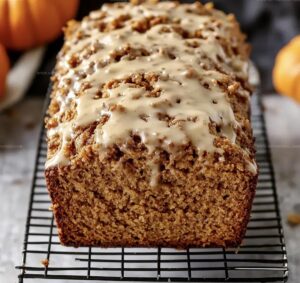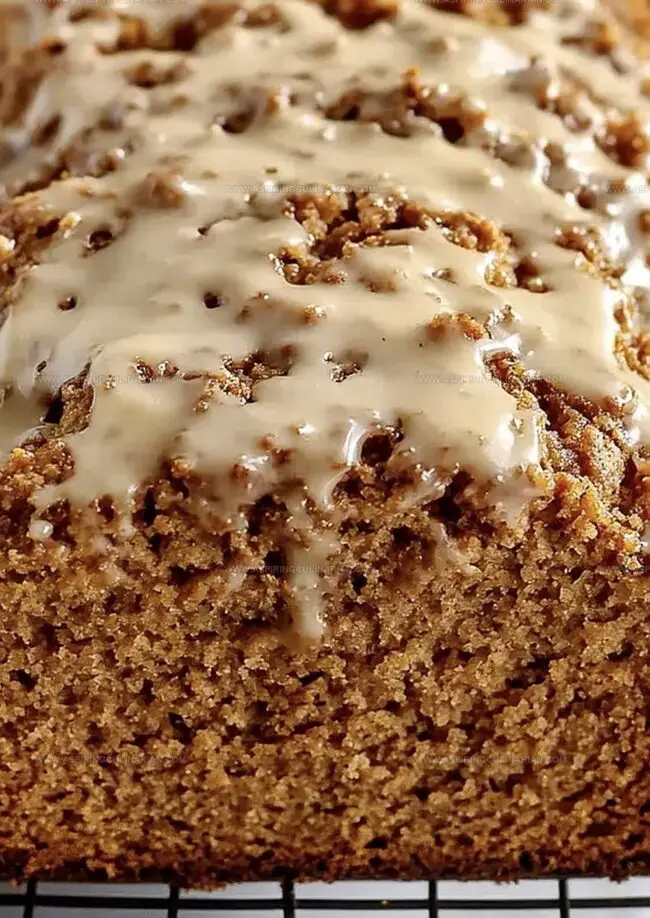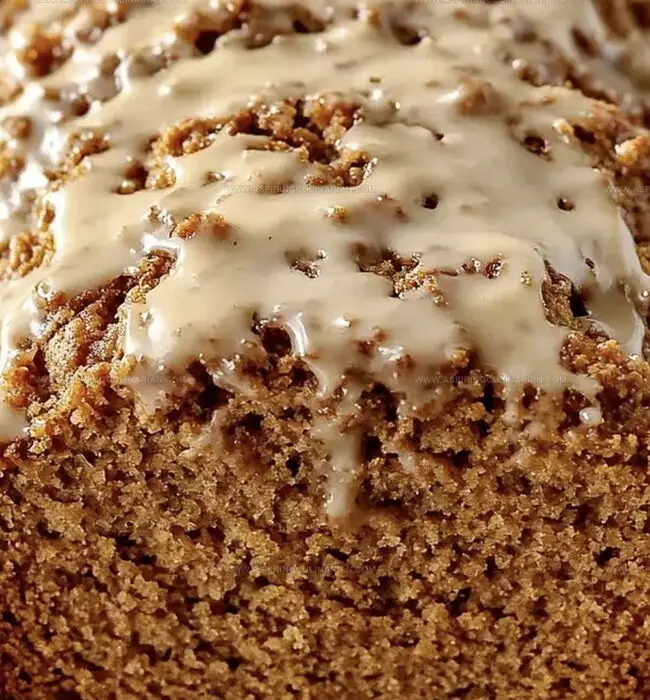Cozy Maple Pumpkin Bread Recipe: Autumn’s Sweet Embrace
Crafting a delightful maple pumpkin bread awakens memories of cozy autumn afternoons.
Crisp leaves dance outside while warm spices fill the kitchen with nostalgic comfort.
Seasonal baking connects us to cherished traditions and simple pleasures.
Fragrant notes of cinnamon and nutmeg blend perfectly with sweet maple undertones.
Rich pumpkin creates a tender, moist crumb that melts in you mouth.
Each slice promises a delectable journey through fall’s most beloved flavors.
Come explore this simple yet extraordinary recipe that will become your new seasonal favorite.
Maple Pumpkin Bread: Sweet Maple Warmth
Maple Pumpkin Bread Ingredient Roundup
Dry Ingredients:Spices:Wet Ingredients:Simple Maple Pumpkin Bread Baking
Step 1: Warm Up the Oven
Get your oven ready by setting it to 350F (175C).
Grab a 9×5-inch loaf pan and give it a light coating of grease to prevent sticking.
Step 2: Blend Dry Ingredients
In a spacious mixing bowl, whisk together these powdery friends:Make sure everything is well combined and free of lumps.
Step 3: Whip Up Wet Ingredients
In another bowl, create a smooth mixture by stirring:Blend until the ingredients dance together harmoniously.
Step 4: Marry the Mixtures
Slowly fold the dry ingredients into the wet ingredients.
Stir gently until just combined – don’t overmix!
The batter should look slightly lumpy but well-integrated.
Step 5: Fill the Pan
Transfer the batter into your prepared loaf pan.
Use a spatula to spread it evenly and create a smooth top.
Step 6: Bake to Perfection
Slide the pan into the preheated oven.
Bake for 50-60 minutes.
To check doneness, insert a toothpick into the center – it should come out clean with just a few moist crumbs.
Step 7: Let It Rest
Remove the bread from the oven and let it chill in the pan for 10 minutes.
Then carefully transfer to a wire rack to cool completely.
Slice, serve, and enjoy your homemade maple pumpkin bread!
Pro Tips for Maple Pumpkin Loaves
Maple Bread Flavors and Twists
Ways to Serve Maple Pumpkin Bread
Storage Tips for Maple Pumpkin Bread
FAQs
Maple syrup adds a rich, deep flavor that complements the pumpkin’s earthiness, creating a more complex sweetness compared to regular sugar and enhancing the bread’s overall taste profile.
While canned pumpkin is recommended for consistent moisture and texture, you can use fresh roasted and pureed pumpkin. Just ensure it’s well-drained and has a similar consistency to canned puree to maintain the bread’s structure.
Insert a toothpick into the center of the bread – if it comes out clean with no wet batter, the bread is done. The top should also be golden brown and slightly springy when touched.
Print
Maple Pumpkin Bread Recipe
- Total Time: 1 hour 15 minutes
- Yield: 12 1x
Description
Comforting maple pumpkin bread delivers autumn’s warmest embrace with rich spices and sweet maple undertones. Bakers will savor each moist, fragrant slice that brings seasonal memories right to your kitchen table.
Ingredients
Main Ingredients:
- 1 cup pumpkin puree
- 2 large eggs
- 1/2 cup maple syrup
- 1/2 cup vegetable oil
- 1/2 cup granulated sugar
Dry Ingredients:
- 1 3/4 cups all-purpose flour
- 1 teaspoon baking soda
- 1/2 teaspoon baking powder
- 1/2 teaspoon salt
Spices:
- 1 teaspoon ground cinnamon
- 1/2 teaspoon ground nutmeg
- 1/2 teaspoon ground ginger
- 1 teaspoon vanilla extract
Instructions
- Prepare the oven by heating to 350F (175C) and coating a 9×5-inch loaf pan with a light layer of grease to prevent sticking.
- Create a dry ingredient blend by thoroughly whisking flour, baking soda, baking powder, salt, and warm spices like cinnamon, nutmeg, and ginger in a spacious mixing bowl.
- In a separate container, combine pumpkin puree, rich maple syrup, granulated sugar, neutral cooking oil, fresh eggs, and aromatic vanilla extract, blending until the mixture achieves a silky, uniform consistency.
- Gradually fold the dry ingredient mixture into the wet ingredients, stirring gently until just incorporated. Avoid overmixing to maintain the bread’s tender texture.
- Transfer the batter into the prepared loaf pan, using a spatula to distribute evenly and smooth the surface for a professional-looking finish.
- Position the pan in the preheated oven and bake for 50-60 minutes. Test for doneness by inserting a toothpick into the center – it should emerge clean and free of raw batter.
- Remove from the oven and let the bread rest inside the pan for 10 minutes, allowing it to set and stabilize before carefully transferring to a wire cooling rack to complete the cooling process.
Notes
- Create a moist, tender texture by avoiding overmixing the batter, which can develop gluten and lead to a tough bread.
- Substitute whole wheat flour for up to half the all-purpose flour to boost nutritional value and add a nutty flavor profile.
- Enhance the bread’s warmth by toasting chopped pecans or walnuts and folding them into the batter before baking for extra crunch and depth.
- Adapt the recipe for dairy-free diets by using coconut oil or neutral vegetable oil instead of traditional baking oils, maintaining the bread’s rich moisture.
- Prep Time: 15 minutes
- Cook Time: 60 minutes
- Category: Breakfast, Snacks, Desserts
- Method: Baking
- Cuisine: American
Nutrition
- Serving Size: 12
- Calories: 189 kcal
- Sugar: 14 g
- Sodium: 130 mg
- Fat: 8 g
- Saturated Fat: 1 g
- Unsaturated Fat: 7 g
- Trans Fat: 0 g
- Carbohydrates: 27 g
- Fiber: 2 g
- Protein: 3 g
- Cholesterol: 37 mg




Nathaniel Brooks
Founder & Recipe Developer
Expertise
Farm-to-table cuisine, Seasonal recipe development, Culinary storytelling
Education
Ivy Tech Community College – Indianapolis, IN
Culinary Arts / Hospitality Administration & Events
Focused on hands-on training in classical and modern culinary techniques.
Nathaniel’s story starts in the foothills of the Appalachian Mountains, where farm stands, backyard gardens, and old family recipes shaped his love for real food. After graduating from Ivy Tech Community College in Indianapolis, he spent years working in farm-to-table kitchens, learning how to turn local, seasonal ingredients into something memorable.
Today, Nathaniel pours that same spirit into every single recipe on Aspiring Culinarian – recipes that feel real, comforting, and connected to the land. When he’s not in the kitchen, you’ll find him foraging wild herbs, chasing sunsets with his camera, or writing about the flavors that shaped his roots.